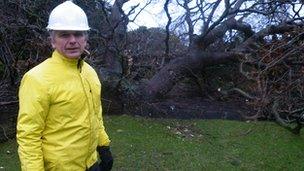'Worst ever' storm damage at Edinburgh botanic garden
- Published

Dr Ian Edwards said the loss of this oak tree was "a tragedy"
The Royal Botanic Garden in Edinburgh has been counting the cost of this week's severe weather.
Hundreds of panels have been smashed in glass houses.
The garden is repairing them as quickly as possible, but it will take much longer to replace more than 40 trees blown over in the storms.
They include some specimens which were hundreds of years old, and others which were important in the history of the collection.
They include a Chinese Tree of Heaven which was collected at the beginning of the 20th Century by the pioneering plant hunter Joseph Rock.
Dr Ian Edwards from the Royal Botanic Garden in Edinburgh (RBGE) told BBC Radio's Good Morning Scotland programme: "it's very sad to see some of my personal favourites, everybody's favourite trees, that have been damaged."
He said the damage was the worst he could remember in almost 30 years of working at the garden.
And if trees are important to humans, they are even more vital to wildlife.
Dr Edwards demonstrated that with a huge native oak which had stood more than 15m (45ft) tall, but had been felled by the winds.
"It's a lovely big specimen tree. Or it was. It's now lying sadly on its side," he said.
"But even though this is a big tree the roots don't go down very deep. They actually only go down about two metres (6ft) into the ground.

From its roots to its crown, the oak was home to many species
"That's often surprising for people."
He explained that the British Oak has more insects associated with it than any other native tree.
"Cracks in the bark would be the home of a great many invertebrates. And these are the food for many of the small birds that live in the Botanic Garden - tits, wrens and tree creepers.
"And these, in turn, are food for some of the bigger, more spectacular, birds, like the garden's two pairs of sparrow hawks."
But the collapse of the tree has allowed experts to see, for the first time ever, what has been going on in the very uppermost branches of these trees.
"This is very exciting for me", Dr Edwards explained.
"These branches are absolutely covered in lichen. And it's not just one species of lichen. There's a whole variety - some of them growing quite luxuriantly."
That matters because lichens are highly sensitive to environmental pollution.
"The fact that there are so many lichens growing here, and they're looking so healthy, is evidence that Edinburgh has got cleaner over the past few decades."
Dr Edwards said the loss of such a tree was "a tragedy" for RBGE.
But, he added: "In some of the more natural woodland areas, this could be seen as nature's way of pruning out diseased and damaged branches and trees.
"You could say that, at the end of that, the wood is healthier than (it was) at the beginning."
The Botanic Garden reopened on Thursday after experts decided it was safe for the public to re-enter the gardens.
- Published22 December 2011
- Published13 May 2011